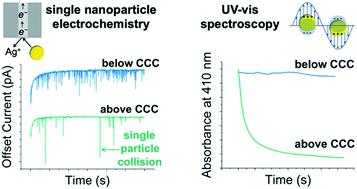当前位置:
X-MOL 学术
›
Environ. Sci.: Nano
›
论文详情
Our official English website, www.x-mol.net, welcomes your
feedback! (Note: you will need to create a separate account there.)
Emerging investigator series: quantifying silver nanoparticle aggregation kinetics in real-time using particle impact voltammetry coupled with UV-vis spectroscopy
Environmental Science: Nano ( IF 5.8 ) Pub Date : 2020-07-17 , DOI: 10.1039/d0en00490a Laela Ezra 1, 2, 3, 4 , Zachary J. O'Dell 1, 2, 3, 4 , Janan Hui 1, 2, 3, 4 , Kathryn R. Riley 1, 2, 3, 4
Environmental Science: Nano ( IF 5.8 ) Pub Date : 2020-07-17 , DOI: 10.1039/d0en00490a Laela Ezra 1, 2, 3, 4 , Zachary J. O'Dell 1, 2, 3, 4 , Janan Hui 1, 2, 3, 4 , Kathryn R. Riley 1, 2, 3, 4
Affiliation

|
The aggregation of silver nanoparticles (AgNPs) as they encounter biological and environmental systems can dictate their fate and transport. Here, we present a rapid, affordable, and robust analytical method for quantifying AgNP aggregation that combines a single particle electrochemistry technique called particle impact voltammetry (PIV) with the strengths of UV-vis spectroscopy. This orthogonal technique, designated PIV/UV-vis, enables the quantitative evaluation of aggregation kinetics by simultaneously measuring changes in the redox behavior of individual AgNPs and spectroscopic changes in the bulk AgNP colloidal solution. We demonstrate that the frequency of AgNP collisions measured by PIV is correlated to the concentration of monodisperse AgNPs in solution. In this way, aggregation can be quantified by the disappearance of AgNP collisions, much like in UV-vis where aggregation is quantified by the rate of disappearance of the localized surface plasmon resonance band of monodisperse AgNPs. The PIV/UV-vis technique was validated by determining the critical coagulation concentration (CCC) of 40 nm AgNPs in the presence of monovalent and divalent cations. The CCC values determined by PIV and UV-vis were in excellent agreement with one another and were determined as 43 ± 4 and 43 ± 3 mM Na+ and 3.0 ± 0.3 and 3.0 ± 0.1 mM Mg2+, respectively. Using dynamic light scattering, aggregation was confirmed by monitoring changes in AgNP hydrodynamic diameter and results show a clear distinction in aggregation behavior above the CCC. Further, zeta potential measurements were used to monitor changes in AgNP surface charge as another measure of colloidal stability. Overall, PIV/UV-vis is a powerful technique to measure AgNP aggregation due to its speed, affordability, reproducibility, and potential broad applicability.
中文翻译:

新兴研究者系列:使用粒子碰撞伏安法和紫外-可见光谱法实时定量银纳米粒子的聚集动力学
当银纳米颗粒(AgNPs)遇到生物和环境系统时,它们的聚集可决定其命运和运输。在这里,我们提出了一种快速,负担得起且健壮的分析方法,用于定量AgNP聚集,该方法结合了一种称为粒子碰撞伏安法(PIV)的单粒子电化学技术与紫外可见光谱技术的优势。这种正交技术称为PIV / UV-vis,它可以通过同时测量单个AgNP的氧化还原行为的变化和整体AgNP胶体溶液的光谱变化,来定量评估聚集动力学。我们证明了通过PIV测量的AgNP碰撞的频率与溶液中单分散AgNP的浓度相关。这样,可以通过AgNP冲突的消失来量化聚集,就像在UV-vis中,聚集是通过单分散AgNP的局部表面等离振子共振带的消失速率来量化的。通过确定存在一价和二价阳离子的40 nm AgNP的临界凝结浓度(CCC),验证了PIV / UV-vis技术。通过PIV和UV-vis确定的CCC值彼此之间非常吻合,确定为43±4和43±3 mM Na分别为+和3.0±0.3和3.0±0.1 mM Mg 2+。使用动态光散射,通过监测AgNP流体动力学直径的变化来确认聚集,结果表明在CCC上方的聚集行为有明显区别。此外,ζ电势测量被用来监测AgNP表面电荷的变化,作为胶体稳定性的另一种测量。总体而言,由于PIV / UV-vis的速度,可负担性,可再现性和潜在的广泛适用性,它是一种测量AgNP聚集的强大技术。
更新日期:2020-09-18
中文翻译:

新兴研究者系列:使用粒子碰撞伏安法和紫外-可见光谱法实时定量银纳米粒子的聚集动力学
当银纳米颗粒(AgNPs)遇到生物和环境系统时,它们的聚集可决定其命运和运输。在这里,我们提出了一种快速,负担得起且健壮的分析方法,用于定量AgNP聚集,该方法结合了一种称为粒子碰撞伏安法(PIV)的单粒子电化学技术与紫外可见光谱技术的优势。这种正交技术称为PIV / UV-vis,它可以通过同时测量单个AgNP的氧化还原行为的变化和整体AgNP胶体溶液的光谱变化,来定量评估聚集动力学。我们证明了通过PIV测量的AgNP碰撞的频率与溶液中单分散AgNP的浓度相关。这样,可以通过AgNP冲突的消失来量化聚集,就像在UV-vis中,聚集是通过单分散AgNP的局部表面等离振子共振带的消失速率来量化的。通过确定存在一价和二价阳离子的40 nm AgNP的临界凝结浓度(CCC),验证了PIV / UV-vis技术。通过PIV和UV-vis确定的CCC值彼此之间非常吻合,确定为43±4和43±3 mM Na分别为+和3.0±0.3和3.0±0.1 mM Mg 2+。使用动态光散射,通过监测AgNP流体动力学直径的变化来确认聚集,结果表明在CCC上方的聚集行为有明显区别。此外,ζ电势测量被用来监测AgNP表面电荷的变化,作为胶体稳定性的另一种测量。总体而言,由于PIV / UV-vis的速度,可负担性,可再现性和潜在的广泛适用性,它是一种测量AgNP聚集的强大技术。











































 京公网安备 11010802027423号
京公网安备 11010802027423号